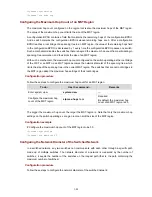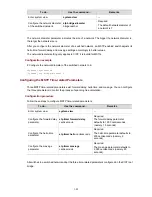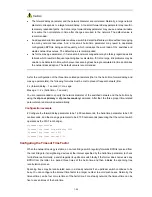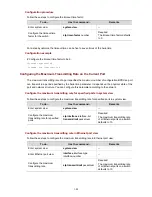
1-10
For this reason, the protocol uses a state transition mechanism. Namely, a newly elected root port and
the designated ports must go through a period, which is twice the forward delay time, before they transit
to the forwarding state. The period allows the new configuration BPDUs to be propagated throughout
the entire network.
z
Hello time, the interval for sending hello packets. Hello packets are used to check link state.
A switch sends hello packets to its neighboring devices at a regular interval (the hello time) to check
whether the links are faulty.
z
Max time, lifetime of the configuration BPDUs stored in a switch. A configuration BPDU that has
“expired” is discarded by the switch.
Rapid Spanning Tree Protocol Overview
Rapid spanning tree protocol (RSTP) is an optimized version of STP. RSTP allows a newly elected root
port or designated port to enter the forwarding state much quicker under certain conditions than in STP.
As a result, it takes a shorter time for the network to reach the final topology stability.
z
In RSTP, the state of a root port can transit fast under the following conditions: the old root port on
the device has stopped forwarding data and the upstream designated port has started forwarding
data.
z
In RSTP, the state of a designated port can transit fast under the following conditions: the
designated port is an edge port or a port connected with a point-to-point link. If the designated port
is an edge port, it can enter the forwarding state directly; if the designated port is connected with a
point-to-point link, it can enter the forwarding state immediately after the device undergoes
handshake with the downstream device and gets a response.
Multiple Spanning Tree Protocol Overview
Why MSTP
1) Disadvantages of STP and RSTP
STP does not support rapid state transition of ports. A newly elected root port or designated port must
wait twice the forward delay time before transiting to the forwarding state, even if it is a port on a
point-to-point link or it is an edge port (an edge port refers to a port that directly connects to a user
terminal rather than to another device or a shared LAN segment.)
RSTP supports rapid convergence. Like STP, it is of the following disadvantages: all bridges in a LAN
are on the same spanning tree; redundant links cannot be blocked by VLAN; the packets of all VLANs
are forwarded along the same spanning tree.
2) Features
of
MSTP
The multiple spanning tree protocol (MSTP) overcomes the shortcomings of STP and RSTP. In addition
to support for rapid network convergence, it also allows data flows of different VLANs to be forwarded
along their own paths, thus providing a better load sharing mechanism for redundant links.
MSTP features the following:
















































